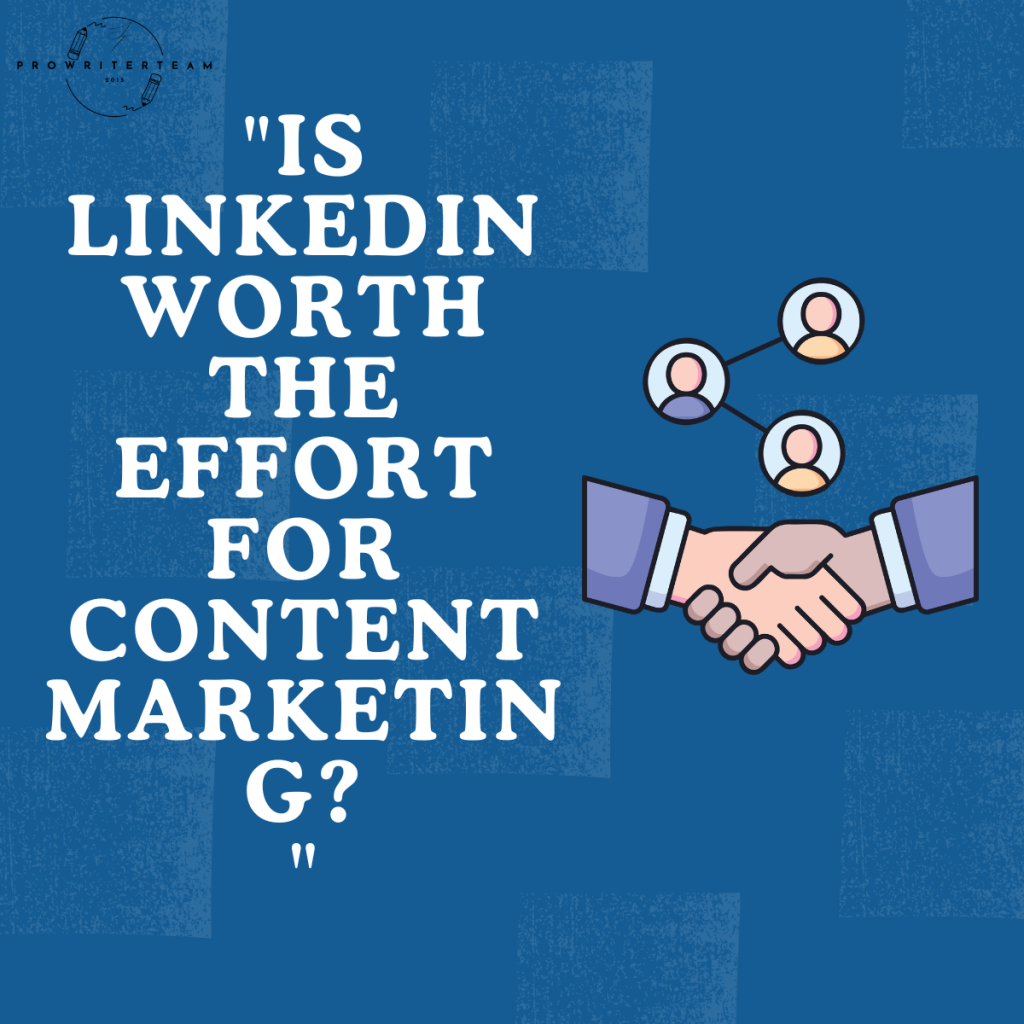Is LinkedIn Worth the Effort for Content Marketing?
Recently, content marketing has become a cornerstone of brand growth and audience engagement. With numerous social media platforms available, marketers must decide where to invest their time and resources for maximum impact.

LinkedIn, often perceived as a professional networking site, has evolved into a powerful platform for content marketing. But is it worth the effort?
This article explores LinkedIn’s potential for content marketing, weighing its benefits against its challenges. We’ll examine:
- The Evolution of LinkedIn as a Content Platform
- Key Benefits of LinkedIn for Content Marketing
- Challenges and Limitations
- Best Practices for Effective LinkedIn Content Marketing
- Success Stories and Case Studies
- Alternatives to LinkedIn for B2B and B2C Marketing
- Final Verdict: Is LinkedIn Worth It?
By the end of this guide, you’ll have a clear understanding of whether LinkedIn should be a priority in your content marketing strategy.
Let’s get to it.
1. The Evolution of LinkedIn as a Content Platform
LinkedIn was launched in 2003 as a professional networking site, primarily for job seekers and recruiters. However, over the past decade, it has transformed into a dynamic content hub where professionals share insights, industry news, and thought leadership.
Key Milestones in LinkedIn’s Growth:
- 2012: Introduction of LinkedIn Influencer Program (now “LinkedIn Top Voices”)
- 2014: Launch of LinkedIn Pulse, a publishing platform for long-form content
- 2016: Microsoft’s acquisition of LinkedIn, leading to enhanced AI and analytics
- 2019-2023: Expansion of video content, newsletters, and creator tools
Today, LinkedIn boasts over 1 billion users, with 4 out of 5 members driving business decisions (LinkedIn Marketing Solutions). This makes it a valuable platform for B2B marketers, entrepreneurs, and even B2C brands targeting professionals.
Want to hire us, get in touch!
2. Key Benefits of LinkedIn for Content Marketing
A. High-Quality, Engaged Audience
Unlike other social networks where engagement can be superficial, LinkedIn users are professionals actively seeking industry insights. This results in:
- Higher engagement rates for thought leadership content
- More meaningful interactions (comments, shares, direct messages)
- Better lead generation for B2B businesses
B. Strong Organic Reach (Compared to Other Platforms)
With Facebook and Instagram becoming increasingly pay-to-play, LinkedIn still offers strong organic reach, especially for:
- Long-form articles
- Engaging posts with actionable insights
- Video content (LinkedIn reports 5x more engagement for videos)
C. Authority Building and Thought Leadership
Publishing on LinkedIn helps establish credibility in your niche. Executives, marketers, and consultants use LinkedIn to:
- Share industry trends
- Publish case studies
- Network with peers and potential clients
D. Advanced Targeting for Paid Campaigns
For those willing to invest in ads, LinkedIn provides unparalleled B2B targeting options, including:
- Job titles, industries, and seniority levels
- Company size and revenue
- Interest-based targeting
E. SEO Benefits
LinkedIn posts rank well on Google, meaning your content can attract passive traffic long after publication.
3. Challenges and Limitations of LinkedIn Content Marketing
Despite its advantages, LinkedIn isn’t perfect. Some key challenges include:
A. Slower Growth for B2C Brands
While B2B companies thrive on LinkedIn, B2C brands (especially those targeting younger audiences) may struggle to gain traction.
B. Algorithm Changes Affecting Reach
LinkedIn’s algorithm prioritizes meaningful engagement over viral content. Low-quality posts (e.g., overly promotional content) get buried quickly.
C. Time-Consuming Content Creation
Unlike Twitter (X) or Instagram, LinkedIn requires well-researched, professional content. This means:
- Longer writing time for articles
- Need for data-backed insights
- Consistent engagement to maintain visibility
D. Limited Virality Compared to Other Platforms
LinkedIn content rarely goes “viral” in the same way TikTok or Twitter threads do. Growth is steady but slower.
4. Best Practices for Effective LinkedIn Content Marketing
To maximize LinkedIn’s potential, follow these proven strategies:
A. Optimize Your Profile for Credibility
- Professional headshot and banner
- Keyword-rich headline and summary
- Clear call-to-action (e.g., “DM for consulting”)
B. Post Consistently (But Focus on Quality)
- Ideal posting frequency: 3-5 times per week
- Mix of formats: text posts, videos, carousels, and articles
C. Leverage LinkedIn Features
- Newsletters: Build a loyal subscriber base
- Polls & Questions: Boost engagement
- Live Video: Increases real-time interaction
D. Engage Authentically
- Comment on industry leaders’ posts
- Respond to every comment on your posts
- Share user-generated content (e.g., client testimonials)
E. Use Analytics to Refine Strategy
Track:
- Post engagement rates
- Follower growth
- Click-through rates on links
Check out this video on YouTube about content marketing on LinkedIn:
5. Success Stories and Case Studies
Case Study 1: HubSpot’s LinkedIn Growth
HubSpot uses LinkedIn to share marketing insights, resulting in the following:
- 500K+ followers
- High engagement in educational content
- Strong lead generation for their SaaS tools
Case Study 2: Personal Branding – Justin Welsh
Entrepreneur Justin Welsh grew his LinkedIn following to 700K+ by:
- Posting daily actionable business tips
- Using storytelling to connect with audiences
- Repurposing content across platforms
6. Alternatives to LinkedIn for B2B and B2C Marketing
If LinkedIn isn’t the right fit, consider:
- Twitter (X): Great for real-time engagement
- Facebook Groups: Community-driven discussions
- Instagram & TikTok: Visual storytelling for B2C
- Industry Forums (Reddit, Quora): Niche audience targeting
7. Final Verdict: Is LinkedIn Worth the Effort?
Yes, If:
✔ You’re in B2B, consulting, or professional services
✔ You’re willing to invest time in high-quality content
✔ Your goal is lead generation and authority building
No, If:
✖ Your audience isn’t active on LinkedIn
✖ You prefer quick, viral content over long-term growth
✖ You’re in a purely B2C niche (e.g., fashion, gaming)
Enjoying this article, check out other posts from ProWriterTeam here.
Conclusion
LinkedIn remains one of the most powerful platforms for B2B content marketing. While it requires effort, the ROI in terms of leads, networking, and brand authority can be substantial. If your audience includes professionals, executives, or businesses, LinkedIn is undoubtedly worth the effort.
ProWriterTeam Verdict on LinkedIn Content Marketing: Is It Worth It?
At ProWriterTeam, we believe LinkedIn is a powerful platform for B2B content marketing. With its professional audience, advanced targeting, and high engagement potential, LinkedIn helps brands build credibility, generate leads, and establish thought leadership.
While organic reach requires consistent, high-quality content, paid promotions can amplify results. For businesses targeting professionals, decision-makers, or industry experts, LinkedIn is absolutely worth it—when done strategically.
What to expect from LinkedIn:
- Professional Audience – Unlike other social platforms, LinkedIn is designed for business professionals, making it ideal for B2B marketing, networking, and thought leadership.
- High Engagement Potential – LinkedIn’s algorithm favors meaningful, long-form content, giving well-crafted posts strong organic reach.
- Lead Generation & Networking – With features like LinkedIn Articles, newsletters, and direct messaging, brands can nurture relationships that convert into sales or partnerships.
- SEO Benefits – Publishing on LinkedIn can improve your visibility in search engines, as content often ranks well on Google.
Tips for using LinkedIn for Content Marketing:
To make LinkedIn work for content marketing, the ProWriterTeam recommends you do the following:
✔ Post consistently (2-3 times per week).
✔ Engage with your network (commenting boosts visibility).
✔ Use multimedia (videos, carousels, and documents perform well).
✔ Leverage LinkedIn Analytics to refine your strategy.
For B2B brands, entrepreneurs, and professionals looking to establish authority, LinkedIn is worth the effort. While it requires a strategic approach, the platform’s engaged audience and business-focused environment make it one of the best channels for content marketing.
Faq
1. Why should I use LinkedIn for content marketing instead of other platforms?
LinkedIn is ideal for B2B marketing, professional networking, and thought leadership. Unlike platforms like Instagram or TikTok, it caters to a business-focused audience, making it perfect for lead generation and industry authority building.
2. Does LinkedIn really generate leads for businesses?
Yes! LinkedIn is one of the top platforms for B2B lead generation. Features like LinkedIn Ads, organic posts, and direct outreach (InMail) help businesses connect with decision-makers effectively.
3. How often should I post on LinkedIn for maximum engagement?
Posting 2-3 times per week is optimal for maintaining visibility without overwhelming your audience. Consistency matters more than frequency—focus on quality content.
4. What type of content performs best on LinkedIn?
- Long-form articles (LinkedIn Articles or detailed posts)
- Engaging videos (tutorials, interviews, thought leadership)
- Carousels & PDFs (visually appealing, educational content)
- Personal stories & case studies (humanizes your brand)
5. Can LinkedIn help with SEO?
Yes! LinkedIn posts and articles often rank on Google, especially if they’re well-optimized with keywords. Your LinkedIn profile can also appear in search results, boosting personal and brand visibility.
6. Is LinkedIn worth it for small businesses or solopreneurs?
Absolutely! LinkedIn allows small businesses to compete with larger brands by leveraging personal branding, networking, and niche content. Many solopreneurs gain clients through LinkedIn engagement alone.
7. How do I measure the success of my LinkedIn content marketing?
Use LinkedIn Analytics to track:
- Post reach & engagement (likes, comments, shares)
- Follower growth
- Click-through rates on links
- Lead conversions (via LinkedIn Sales Navigator or website traffic)
8. Should I use LinkedIn Ads for content marketing?
If you have a budget, LinkedIn Ads can amplify your content to a targeted audience. However, organic content can also perform well with the right strategy.
9. Does LinkedIn work for B2C marketing, or is it only for B2B?
While LinkedIn is primarily B2B-focused, some B2C brands (especially in finance, real estate, coaching, and luxury services) succeed by targeting professionals as consumers.
10. What’s the biggest mistake people make with LinkedIn content marketing?
Posting overly promotional content without providing value. LinkedIn users prefer insights, education, and storytelling over hard sales pitches.
This article provides a comprehensive breakdown of why content marketing should be a top priority, with data-backed insights and real-world examples.

